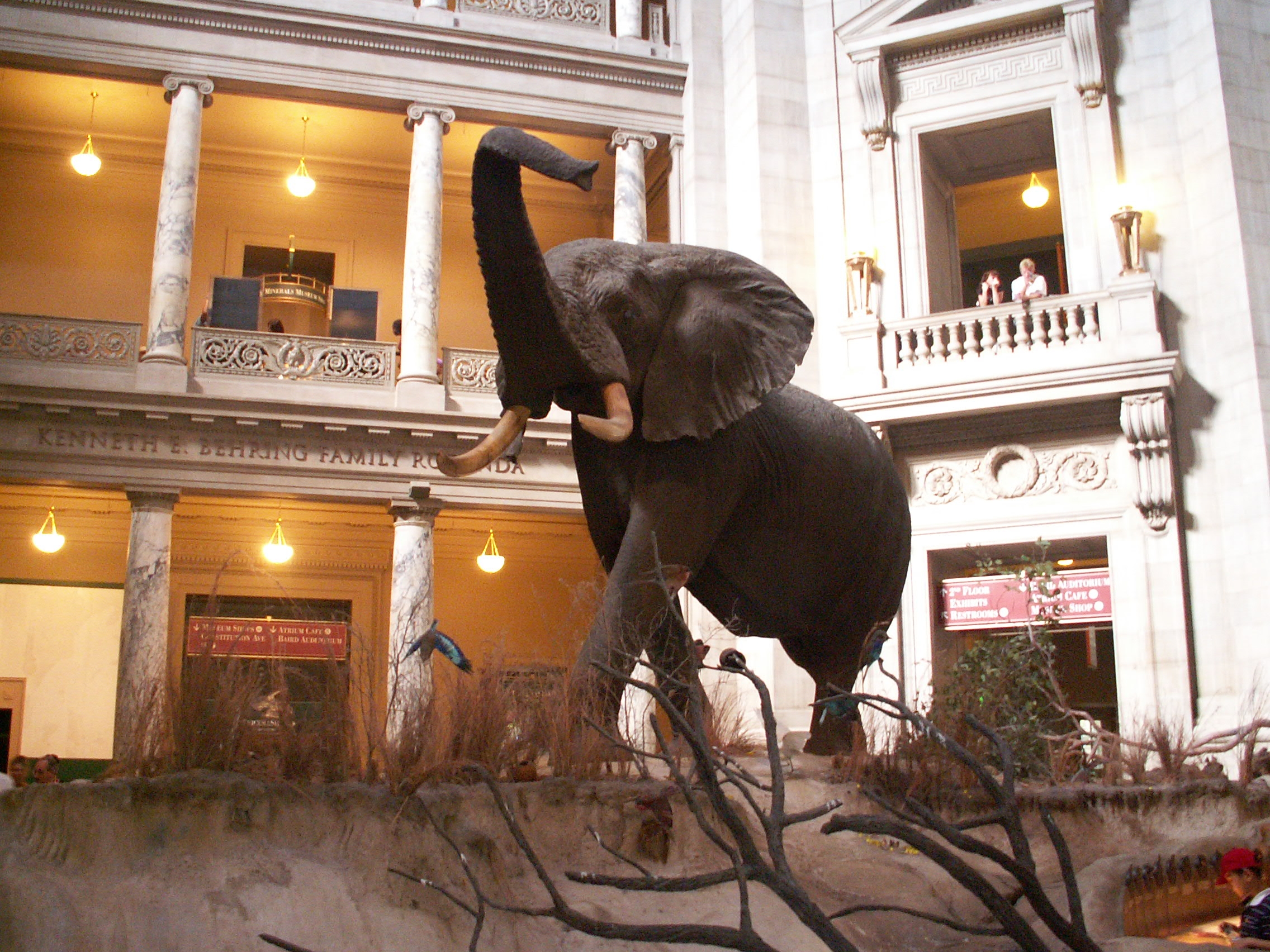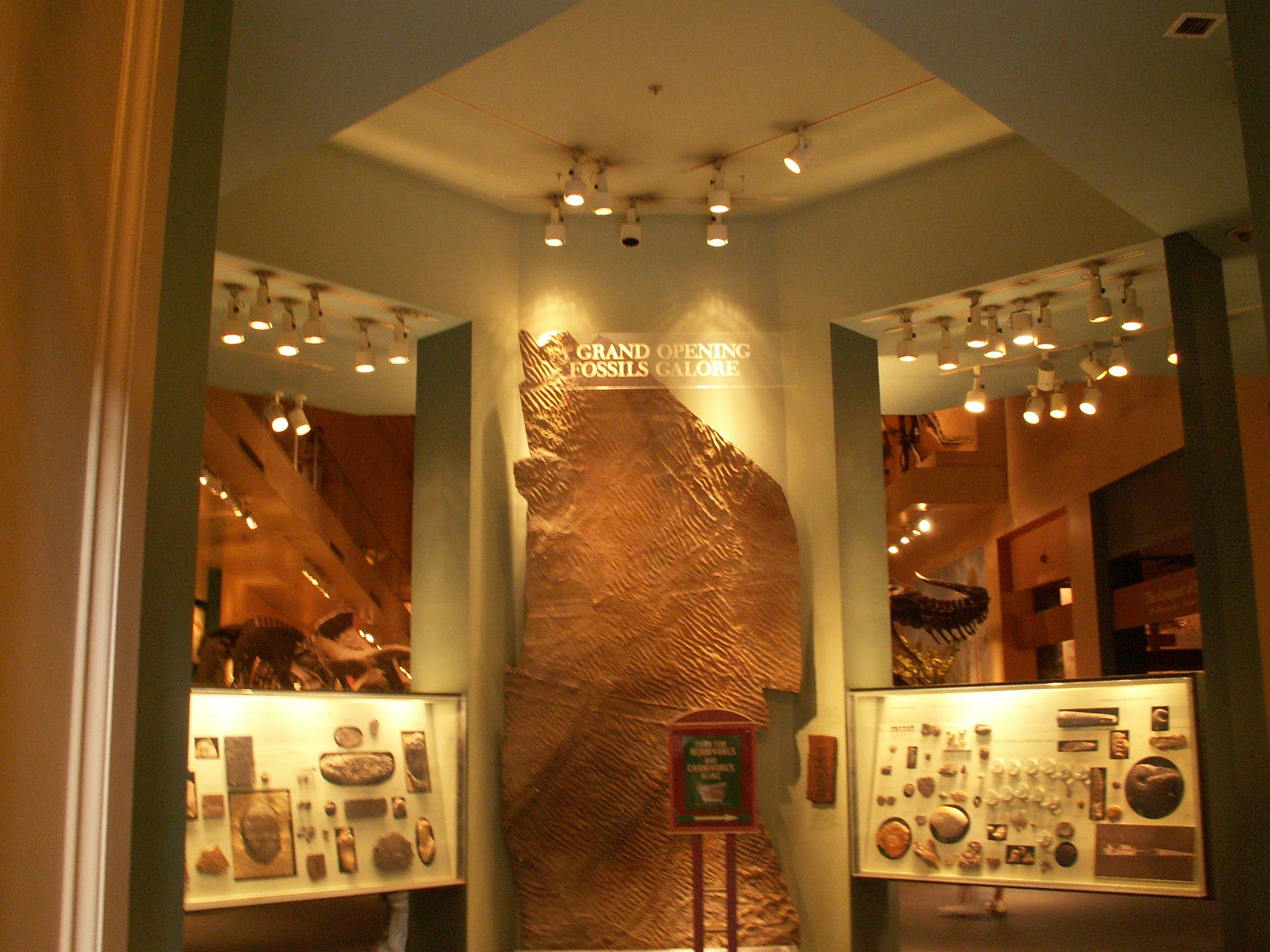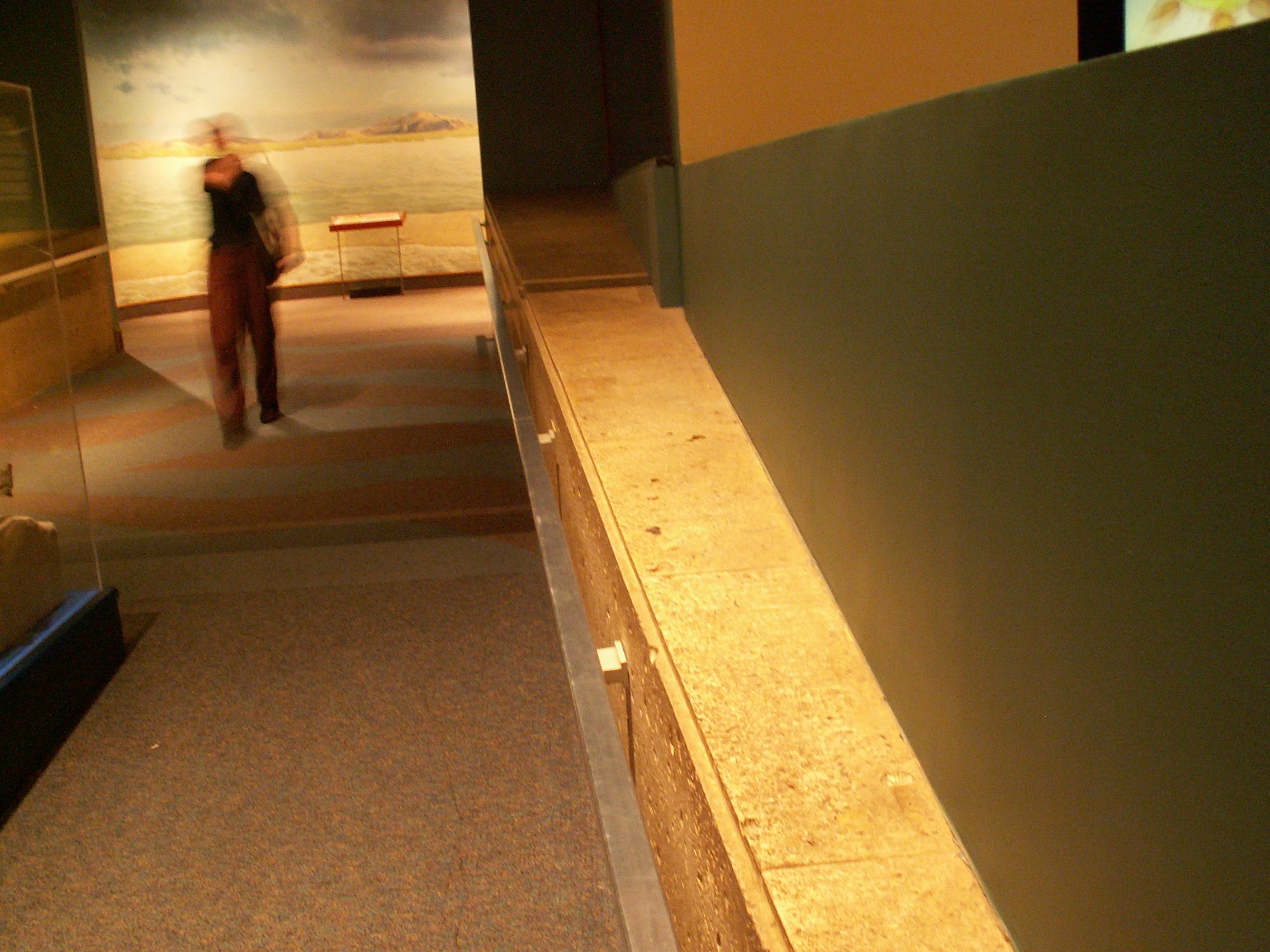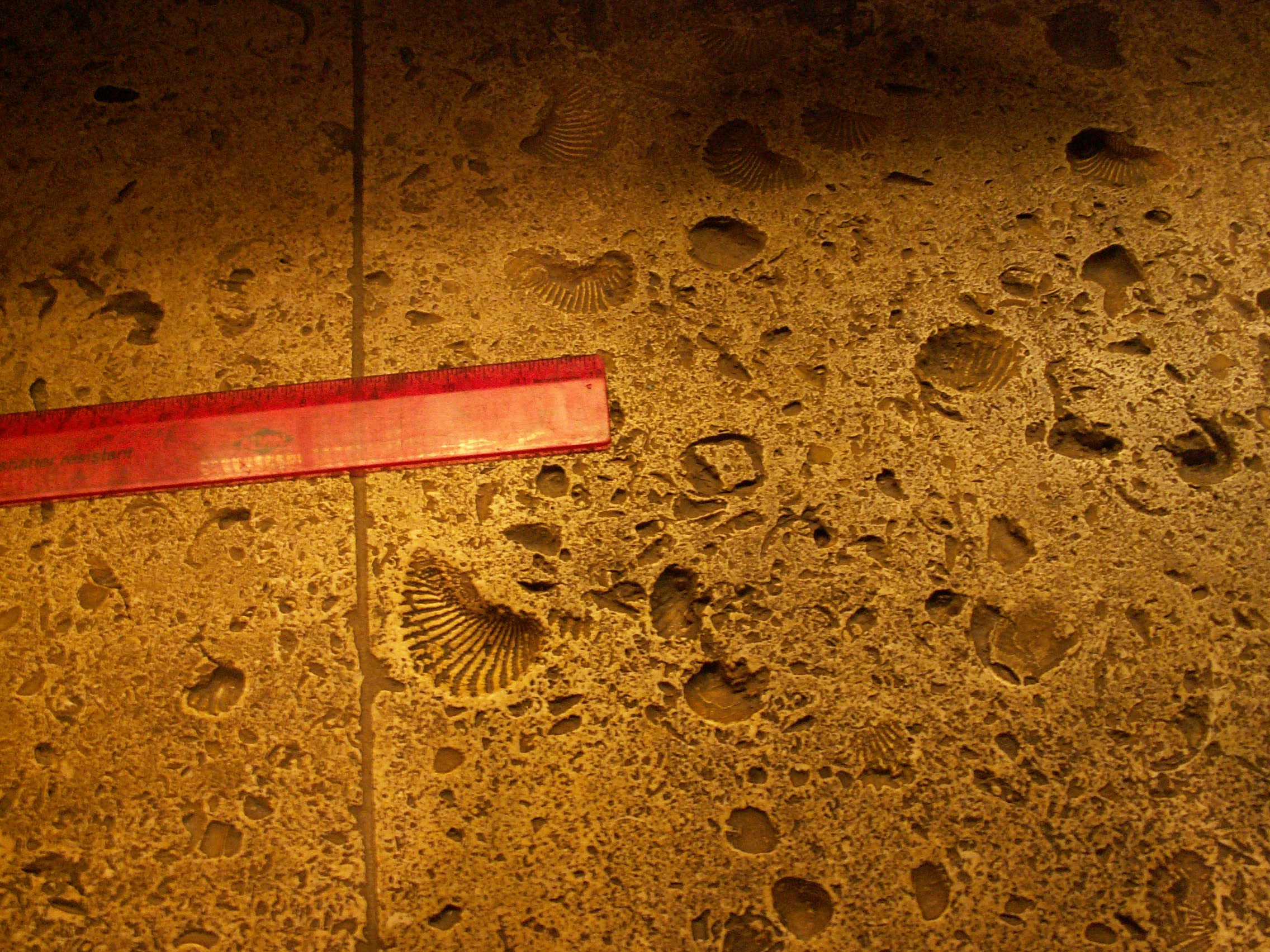Introduction
Fossils of the Whitestone Lentil
Origins of the Whitestone Lentil in the Mid-Cretaceous period of Texas
The Whitestone Lentil as “Cordova Shell” Building Stone
Acknowledgments and Sources
“Let’s meet at the elephant.” The elephant has long been a preferred starting point for visitors trying to rendezvous at the Smithsonian’s National Museum of Natural History, on Constitution Ave., N.W. between Ninth and Twelfth St. It is a logical choice. The elephant is impossible to miss under the high dome of the museum’s rotunda:

The elephant is also the proper starting point to find another Gallery of the Accidental Museum of Paleontology as well – a Gallery buried deep within the heart of D.C.’s real museum of paleontology. First, turn toward the east wing of the building – the dinosaur wing.

Approach the tall fossil-bearing rock slab visible through the portal:

Walk around to the right. Ahead loom tall dinosaur fossils in lifelike poses. They are not the destination. Just short of the Tyrannosaurus Rex, a ramp appears to the right, leading up towards the exhibit showing life’s conquest of the land. Do not walk up the ramp yet. Instead, note the stone railing along each side:

Take a close look at that stone. You will see fossils — many large, easily distinguished fossils, in the form of shell molds:

This stone was quarried near Austin, Texas. It is sold under the trade name, “Cordova Shell Limestone,” but its source is known geologically as the “Whitestone Lentil.” It formed approximately 105 million years ago during the middle of the Cretaceous period – the height of the so-called “age of dinosaurs.”
The actual museum of paleontology, literally in the shadow of dinosaur exhibits, seems a very odd place to find an exhibit of the Accidental Museum. But the railings cannot fairly be considered as part of the real museum’s own exhibits. Perhaps they once were.
When first installed circa 1960, the stone was part of the dinosaur exhibit – a rare example of a building stone chosen specifically because its fossils’ geological age complemented the built environment. Fossil-bearing limestone from the Cretaceous period matched an exhibit of dinosaurs. However, roughly 20 years later, the Museum reorganized the exhibits into its current layout. Now, the ramp forms the entrance to an exhibit set in the mid-Paleozoic – more than 100 million years before the Mesozoic began, and more than 200 million years before the era of the Whitestone Lentil. Although some among the museum staff noted the discrepancy in geologic age, the stone was kept on the general premise that the ramp suggested emergence from the marine world.
Today, the stone railings are unmarked, unlabeled, and largely ignored by visitors. Formerly, the fossils harmonized subtly with their exhibits. Now, they are anachronisms – Mesozoic fossils leading into a Paleozoic exhibit. But they are well worth a visit.
Fossils of the Whitestone Lentil
The visible fossils here are all molds. The original shells – made of less durable aragonite — dissolved, leaving detailed hollows in the calcite of the stone.
Trigonia
By far the most easily identified fossil is Trigonia, a clam-like pelecypod. A large, well-defined example can be seen a couple of inches below the end of the ruler in this photograph:

Turritella
Scattered over the surface of the stone are also some smaller molds in elongated, narrow, triangular shapes, like the one appearing to the left of the end of the end of the ruler in the photograph below:

These are molds of Turritella, high-spired gastropods, which in life would have resembled modern snails. The probable genus of this specimen is Turritella seriatim-granulata
Other gastropods and bivalves.

The photograph above shows a large, shallow mold of a lower-spired gastropod, several inches to the left of the end of the ruler. Bivalve shell impressions can also be seen nearby. The gastropod strikingly resembles a modern gastropod; if one were to see them as impressions on the sand of a modern beach, they would not rate a second glance.
Origins of the Whitestone Lentil in the Mid-Cretaceous period of Texas
Today, the Whitestone Lentil is an elongated mound of limestone within the larger Walnut Formation of Texas, trending northwest-southeast along the boundary between Travis and Williamson counties. It outcrops along a belt slightly more than forty miles long and between 5 and 20 miles wide. Its origins lie in the mid-Cretaceous, approximately 105 million years ago.
Much of Texas during the mid-Cretaceous period was covered by shallow seas, which at times stretched to the current northern state border. The Whitestone Lentil appears to have been formed as an offshore bar, parallel to the ancient shoreline. This bar developed in a shallow marine environment, in which the level of agitation lessened from northeast to southwest, where more abundant quiet water deposits occurred.
Within the Whitestone Lentil are four differing “facies,” or granular structures, of limestone, each reflecting a different depositional environment in and around the offshore bar during the Cretaceous. Only one of these — the bioclastic facies — is quarried as Cordova Shell building stone.
Sedimentary structures can be seen within the Whitestone Lentil, and they allow geologists to understand the living environment at the time. Cross-bedding and ripple marks (see Gallery 6) found throughout the formation show that it occurred in a high-energy environment – i.e., an environment with active currents and even waves. The grains of the formation were deposited by currents flowing northwest to southwest. Some currents, likely tidal in nature, moved through the bar in surge channels. Most of the fossils in the Cordova Shell stone appear to have occurred on the flanks of these surge channels. Although the visible fossil selection may not fully reflect the nearby marine community, it appears to have been rich in various pelecypods (including Trigonia), gastropods and corals.
The Whitestone Lentil as “Cordova Shell” Building Stone
The Whitestone Lentil stone has been quarried from deposits in the Austin area since the early 1900s and is still quarried today by the Texas Quarries company. Although no other display has yet been located in Washington, the Cordova Shell stone has been used in many buildings inside and outside Texas. For example, the 1939 City Hall of Houston displays the Trigonia fossils, as do at least a dozen buildings in the heart of the University of Texas campus.
A Washingtonian visiting Texas’ San Jacinto Battleground State Historic Site can view a massive display of this stone in a very familiar shape – see the photograph found at the relevant Texas Parks and Wildlife Department website, http://www.tpwd.state.tx.us/spdest/findadest/parks/san_jacinto_battleground/monument.phtml. The 570 foot tall obelisk rising above the battlefield is strangely reminiscent of the Washington Monument — except for the massive Star of Texas perched at its top. The monument is faced with the Cordova Shell Limestone. Perhaps by chance, this monument honoring Texas independence was built to be slightly taller than the 555-foot tall Washington Monument.
Acknowledgments and Sources [1]
Special thanks are due to:
Raymond Rye, for pointing out the fossils and providing background on their changing role in the exhibits; and
Dr. Ann Molyneux, of the University of Texas, for identifying the fossils and providing references and additional information regarding the origins of the Whitestone Lentil and its fauna.
Identification of the stone. Raymond Rye identified the stone as a Cretaceous stone from Texas. Further internet research, particularly in the internet edition of Walking the Forty Acres: Building Stones – Precambrian to Pleistocene, by S.P. Ellison and Joseph J. Jones, The University of Texas at Austin Retired Faculty-Staff Association, http://www.lib.lib.utexas.edu/geo/fortyacres/40 acres3.html, allowed identification of the stone as Cordova Shell Limestone possible, based in large part on the highly visible Trigonia fossil. Dr. Ann Molyneux confirmed the fossils as being of the Whitestone Lentil.
Origins of the stone and paleoenvironment. Personal communication, Dr. Ann Molyneux; Moore, Jr., C.H., and Martin, K.G., 1966, “Comparison of Quartz and Carbonate Shallow Marine Sandstones, Fredericksburg Cretaceous, Central Texas:” American Association of Petroleum Geologists Bulletin, v.50, p. 981-1000; Perkins, B.F. and Stewart, C.L., 1971, “Stop 3: Whitestone Quarry,” in B.F. Perkins, ed., Trace Fossils, A field guide to selected localities in Pennsylvanian, Permian, Cretaceous, and Tertiary Rocks of Texas and related papers, SEPM Field Trip, April 1-3, 1971: School of Geoscience Miscellaneous Publications 71-1, Louisiana State University, p.17-22.
Other uses of the stone in architecture. http://texasquarries.com/, http://houstontx.gov/hr/savvypages/archives/Fall02/fall02_cityhall.htm;
http://www.tpwd.state.tx.us/spdest/findadest/parks/san_jacinto_battleground/monument.phtml,
[1] Where this website cites specific internet page addresses, they are typically the addresses used by the author in researching and writing this discussion – a process taking several years. Unfortunately, in the meantime a number of the specific addresses have changed, and will continue to change, rendering some of these addresses ineffective as links. Readers should be able to find the material by searching for the proper name of the cited article or material on a search engine.
